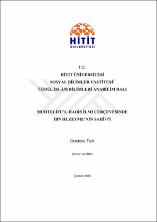Muhtelifü'l-hadîs ilmi çerçevesinde İbn Huzeyme'nin sahîh'i
Citation
Aydın, O. (2020). Muhtelifü'l-hadîs ilmi çerçevesinde İbn Huzeyme'nin sahîh'i (Doktora Tezi).Abstract
Malum olduğu üzere Muhtelifü'l-hadîs, hadîs ilimleri içerisindeki en zor disiplinlerden biridir. Bununla birlikte, hicrî ikinci asrın son çeyreğinden itibaren bu sahaya dair pek çok kayda değer eser ortaya konmuştur. Bu bağlamda bizim çalışmamızda da; hicrî üçüncü asır âlimlerinden İbn Huzeyme'nin mezkûr disipline ilişkin yorumları, mukayeseli olarak değerlendirmeye tabi tutulmaktadır. Giriş ve üç bölümden oluşan çalışmanın Birinci Bölüm'ünde; İbn Huzeyme'nin hayatı ve ilmî kişiliği ile kavramsallaşma sürecinde Muhtelifü'l-hadîs ilminin gelişim safhaları ele alınmakta; İkinci Bölüm'de, müellifin hadisçi kimliği, gerek senet gerekse metin merkezli tetkîke açılmakta; Üçüncü Bölüm'de ise bu ilme ait kriterler, İbn Huzeyme'nin kullanışı açısından örnekler eşliğinde tespite çalışılmaktadır. Yaşadığı dönem itibarıyla farklı mezhebî eğilimlere mensup ulema tarafından görüş ve eser türünden bu ilme dair oluşmuş birikim yanında, alanın bir diğer otoritesi olan İbn Huzeyme'nin tetkîke konu edilmesi; kendisinin fikir ve tasarrufları üzerinden farklılığını ortaya koyacak ve ilgili disiplin içerisindeki yerinin görülmesine katkı sağlayacaktır. As it is known, Mukhtalif al-Hadith is one of the most difficult disciplines in hadith sciences. Nevertheless, many important works have been written in this area towards the end of the eighth century. In this context, in our study; The interpretations of Ibn Huzeyme, one of the nineteenth century scholars, will be examined comparatively. In the First Part of the study, which consists of an introduction and three parts; In the process of Ibn Huzaymah's life, his scientific personality and conceptualization, the development process shown by the science of Mukhtalif al-Hadith is discussed. In the second chapter, the identity of the author as a hadith scholar; both isnad and hadith texts are analyzed by taking them in the center. In the third chapter, the norms of this science are tried to be determined in terms of the use of Ibn Huzaymah and in the light of examples. In terms of the period he lived; in addition to the opinions and studies put forward by scholars of different sectarian trends, examining Ibn Huzaymah, another authority of this field, will reveal its originality in terms of ideas and savings and contribute to its emergence of its place in this science.


















